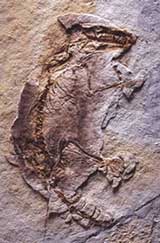Tree-climbing with dinosaurs

Most mammals of this vintage are known only by their teeth. <br>© Nature <br>
Fossil find hints at life of one of our earliest mammalian forebears.
A mouse-sized fossil from 125 million years ago is the earliest known member of the mammal group that includes humans, say researchers.
The animal is a primitive example of today’s dominant mammals. “It’s at the very root of this diverse and incredibly important group,” says palaeontologist Zhe-Xi Luo of the Carnegie Museum of Natural History in Pittsburgh1.
The mammal, Eomaia scansoria, might have scampered up a tree as a feathered dinosaur ran past. The animal’s elongated digits suggest that it was adept at climbing; its name translates as ’dawn-mother climber’.
Luo and his colleagues discovered Eomaia in China. Its skeleton is exceptionally well preserved, and the fossil shows its dense fur. Most mammals of a similar vintage are known only by their teeth.
Eomaia’s teeth and ankle-bones mark it out as a member of the group called the Eutheria, rather than a marsupial or one of the egg-laying group called monotremes.
But Eomaia probably lacked a placenta, and would have reproduced in a similar way to modern marsupials. Its hips are too narrow to give birth to large young; its babies would have been born at an early stage of development and clung to their mother for shelter and nourishment.
Eomaia was discovered in a fossil lakebed. When it lived, the surrounding landscape would have been lush and densely vegetated. The animal’s teeth suggest that it ate insects, and it may have led a shrew-like life in bushes and trees.
Treasure trove
The rocks that hold Eomaia are a fossil treasure trove, containing many beautifully preserved animals, including feathered dinosaurs. There are also other mammals, ranging from beasts smaller than Eomaia to a predator slightly larger than a domestic cat. These other species seem to have been less well adapted for climbing.
“What’s so cool is that we’re beginning to get some sense of how these animals lived together,” says palaeontologist Anne Weil of Duke University in Durham, North Carolina. Although, she warns, reconstructing fossils’ lives is “a bit of a guessing game”.
Mammals were already a diverse group by this stage, adds palaeontologist Jerry Hooker of the Natural History Museum, London. “We must go back further to look for even older eutherians,” to truly understand the evolution of early mammals, he says.
Fossils suggest that there were seven mammal lineages present at his time – our ancestors would have been “just another face in the crowd”, says Weil. But only three of these groups survive today. Three died out while dinosaurs still roamed, the fourth about 35 million years ago.
Early marsupials – another lineage that survived and thrived – seem also to have been tree dwellers. An ability to climb might have given them, like Eomaia, the edge over their contemporaries, Weil suggests.
References
- Ji, Q. et al. The earliest eutherian mammal. Nature, 416, 816 – 822, (2002).
Media Contact
All latest news from the category: Life Sciences and Chemistry
Articles and reports from the Life Sciences and chemistry area deal with applied and basic research into modern biology, chemistry and human medicine.
Valuable information can be found on a range of life sciences fields including bacteriology, biochemistry, bionics, bioinformatics, biophysics, biotechnology, genetics, geobotany, human biology, marine biology, microbiology, molecular biology, cellular biology, zoology, bioinorganic chemistry, microchemistry and environmental chemistry.
Newest articles

Making diamonds at ambient pressure
Scientists develop novel liquid metal alloy system to synthesize diamond under moderate conditions. Did you know that 99% of synthetic diamonds are currently produced using high-pressure and high-temperature (HPHT) methods?[2]…

Eruption of mega-magnetic star lights up nearby galaxy
Thanks to ESA satellites, an international team including UNIGE researchers has detected a giant eruption coming from a magnetar, an extremely magnetic neutron star. While ESA’s satellite INTEGRAL was observing…

Solving the riddle of the sphingolipids in coronary artery disease
Weill Cornell Medicine investigators have uncovered a way to unleash in blood vessels the protective effects of a type of fat-related molecule known as a sphingolipid, suggesting a promising new…





















